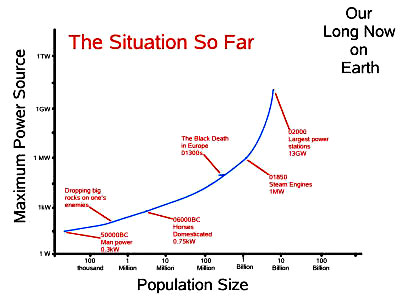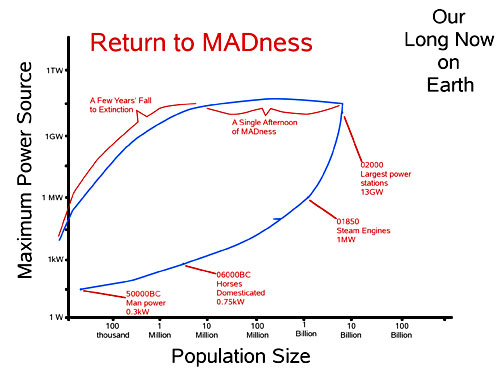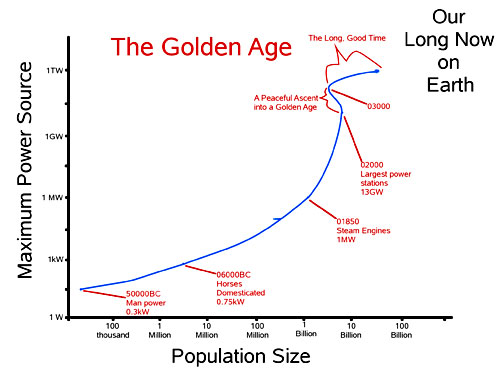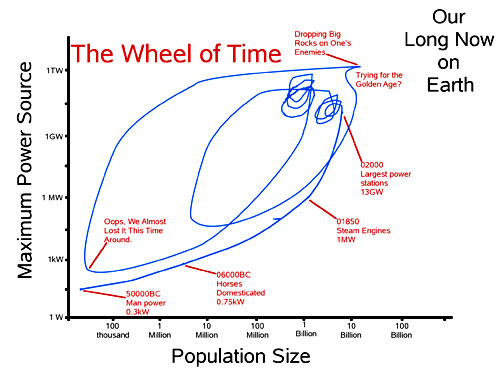|

by Vernor Vinge
2007
from
Kurzweilai Website
|
It's 2045 and nerds in
old-folks homes are wandering around, scratching their heads, and
asking plaintively, "But ... but, where's the Singularity?"
Science fiction writer Vernor
Vinge - who originated the concept of the technological Singularity
- doesn't think that will happen, but he explores three alternate
scenarios, along with our "best hope for long-term survival" -
self-sufficient, off-Earth settlements.
Originally presented at Long Now Foundation
Seminars About Long Term Thinking, February 15, 2007.
Published with permission on KurzweilAI.net March 14, 2007.
|
Just for the record
Given the title of my talk, I should define and briefly discuss what
I mean by the Technological Singularity:
It seems plausible that with
technology we can, in the fairly near future, create (or become)
creatures who surpass humans in every intellectual and creative
dimension. Events beyond this event - call it the Technological
Singularity - are as unimaginable to us as opera is to a flatworm.
The preceding sentence, almost by
definition, makes long-term thinking an impractical thing in a
Singularity future.
However, maybe the Singularity won't happen, in which case planning
beyond the next fifty years could have great practical importance.
In any case, a good science-fiction writer (or a good scenario
planner) should always be considering alternative outcomes.
I should add that the alternatives I discuss tonight also assume
that faster-than-light space travel is never invented! Important
note for those surfing this talk out of context. I still regard the
Singularity as the most likely non-catastrophic outcome for our near
future.
There are many plausible catastrophic scenarios (see Martin Rees's
Our Final Hour), but tonight I'll
try to look at non-singular futures that might still be survivable.
The Age of Failed
Dreams
A plausible explanation for "Singularity failure" is that we never
figure out how to "do the software" (or "find the soul in the
hardware", if you're more mystically inclined).
Here are some possible symptoms:
-
Software creation continues as
the province of software engineering.
-
Software projects that endeavor
to exploit increasing hardware power fail in more and more
spectacular ways.
-
Project failures so deep
that no amount of money can disguise the failure;
walking away from the project is the only option.
-
Spectacular failures in
large, total automation projects. (Human flight
controllers occasionally run aircraft into each other; a
bug in a fully automatic system could bring a dozen
aircraft to the same point in space and time.)
-
Such failures lead to reduced
demand for more advanced hardware, which no one can properly
exploit - causing manufacturers to back off in their
improvement schedules. In effect, Moore's Law fails - even
though physical barriers to further improvement may not be
evident.
-
Eventually, basic research in
related materials science issues stagnates, in part for lack
of new generations of computing systems to support that
research.
-
Hardware improvements in simple
and highly regular structures (such as data storage) are the
last to fall victim to stagnation. In the long term, we have
some extraordinarily good audio-visual entertainment
products (but nothing transcendental) and some very large
data bases (but without software to properly exploit them).
-
So most people are not surprised
when the promise of strong AI is not fulfilled, and other
advances that would depend on something like AI for their
greatest success - things like nanotech general assemblers -
also elude development.
All together, the early years of this
time come to be called the "Age of Failed Dreams."
Broader
characteristics of the early years
-
It's 2040 and nerds in old-folks
homes are wandering around, scratching their heads, and
asking plaintively, "But ... but, where's the Singularity?"
-
Some consequences might seem
comforting:
-
Edelson's Law says: "The
number of important insights that are not being made is
increasing exponentially with time."
I see this caused
by the breakneck acceleration of technological
progress - and the failure of merely human minds to keep
up. If progress slowed, there might be time for us to
begin to catch up (though I suspect that our bioscience
databases would continue to be filled faster than we
could ever analyze).
-
Maybe now there would
finally be time to go back over the last century of
really crummy software and redo things, but this time in
a clean and rational way. (Yeah, right.)
-
On the other hand, humanity's
chances for surviving the century might become more dubious:
-
Environmental and resource
threats would still exist.
-
Warfare threats would still
exist. In the early years of the 21st century, we have
become distracted and (properly!) terrified by nuclear
terrorism. We tend to ignore the narrow passage of
1970-1990, when tens of thousands of nukes might have
been used in a span of days, perhaps without any
conscious political trigger. A return to
MAD is very
plausible, and when stoked by environmental stress, it's
a very plausible civilization killer.
Envisioning
the resulting Long Now possibilities
Suppose humankind survives the 21st century. Coming out of the Age
of Failed Dreams, what would be the prospects for a long human era?
I'd like to illustrate some
possibilities with diagrams that show all of the Long Now - from tens
of thousands of years before our time to tens of thousands of years
after - all at once and without explicit reference to the passage of
time (which seems appropriate for thinking of the Human Era as a
single long now!).
Instead of graphing a variable such as population as a function of
time, I'll graph the relationship of an aspect of technology against
population size.
By way of example, see below image for
our situation so far.

It doesn't look very exciting.
In fact, the most impressive thing is
that in the big picture, we humans seem a steady sort. Even the
Black Death makes barely a nick in our tech/pop progress. Maybe this
reflects how things really are - or maybe we haven't seen the whole
story. (Note that extreme excursions to the right (population) or
upwards (related to destructive potential) would probably be
disastrous for civilization on Earth.)
Without the Singularity, here are three possibilities
(scenarios in their own right):
Scenario 1 - A Return to MADness

-
I said I'd try to avoid
existential catastrophes, but I want to emphasize that
they're still out there. Avoiding such should be at the top
of ongoing thinking about the long-term.
-
The "bad afternoon" going back
across the top of the diagram should be very familiar to
those who lived through the era of:
-
Fate of the Earth by
Jonathan Schell
-
TTAPS (a report dubbed "TTAPS"
study, from the initials of the last names of its
authors, R.P. Turco, O.B. Toon, T.P. Ackerman, J.B.
Pollack, and C. Sagan.)
Nuclear Winter claims
-
Like many people, I'm
skeptical about the two preceding references. On the
other hand, there's much uncertainty about the effects
of a maximum nuclear exchange. The subtle logic of MAD
planning constantly raises the threshold of "acceptable
damage", and engages very smart people and enormous
resources in assuring that ever greater levels of
destruction can be attained. I can't think of any other
threat where our genius is so explicitly aimed at our
own destruction.
Scenario 2 - The Golden Age

(A scenario to balance the pessimism
of A Return to MADness - above Scenario 1 image)
-
There are trends in our era that
tend to support this optimistic scenario:
-
The plasticity of the human
psyche (on time scales at least as short as one human
generation). When people have hope, information, and
communication, it's amazing how fast they start behaving
with wisdom exceeding the elites.
-
The Internet empowers such
trends, even if we don't accelerate on into the
Singularity. (My most recent book,
Rainbows End, might
be considered an illustration of this (depending on how
one interprets the evidence of incipiently transhuman
players.)
-
This scenario is similar to
Gunther Stent's vision in
The Coming of the Golden Age, a
View of the End of Progress (except that in my version there
would still be thousands of years to clean up after Edelson's law).
-
The decline in population (the
leftward wiggle in the trajectory) is a peaceful, benign
thing, ultimately resulting in a universal high standard of
living.
-
On longest time horizon, there
is some increase in both power and population.
-
This civilization apparently
reaches the long-term conclusion that a large and happy
population is better than a smaller happy population.
The reverse could be argued. Perhaps in the fullness of
time, both possibilities were tried.
-
So what happens at the far
end of this Long Now (20000 years from now, 50000)? Even
without the Singularity, it seems reasonable that at
some point the species would become something greater.
-
A policy suggestion (applicable
to most of these scenarios): [Young] Old People are good for
the future of Humanity! Thus prolongevity research may be
one of the most important undertakings for the long-term
safety of the human race.
-
This suggestion explicitly
rejects the notion that lots of old people would deaden
society. I'm not talking about the moribund old people
that we humans have always known (and been). We have no
idea what young very old people are like, but their
existence might give us something like the advantage the
earliest humans got from the existence of very old tribe
members (age 35 to 65).
-
The Long Now perspective
comes very naturally to someone who expects that not
only his/her g*grandchildren will be around in 500
years - so may be the individual him/herself.
-
And once we get well into
the future, then besides having a long prospective view,
there would be people who have experienced the distant
past.
Scenario 3 - The Wheel of Time

I fear this scenario is much more
plausible than The Golden Age (above Scenario 2 image).
The Wheel of Time is based on
fact that Earth and Nature are dynamic and our own technology
can cause terrible destruction. Sooner or later, even with the
best planning, mega-disasters happen, and civilization falls (or
staggers).
Hence, in this diagram we see cycles
of disasters and recovery.
There has been a range of
speculation about such questions (mostly about the first
recovery):
In fact, we know almost nothing
about such cycles - except that the worst could probably kill
everyone on Earth.
How to deal with the
deadliest uncertainties
A frequent catchphrase in this talk has been "Who knows?".
Often this mantra is applied to the most
serious issues we face:
-
How dangerous is MAD, really?
(After all, "it got us through the 20th century alive".)
-
How much of an existential
threat is environmental change?
-
How fast could humanity recover
from major catastrophes?
-
Is full recovery even possible?
-
Which disasters are the most difficult to recover from?
-
How close is technology to
running beyond nation-state MAD and giving irritable
individuals the power to kill us all?
-
What would be the long-term
effect of having lots of young old people?
-
What is the impact of
[your-favorite-scheme-or-peril] on long-term human survival?
We do our best with scenario planning.
But there is another tool, and it is wonderful if you have it: broad
experience.
-
An individual doesn't have to
try out every recreational drug to know what's deadly.
-
An individual has in him/herself
no good way of estimating the risks of different styles of
diet and exercise. Even the individual's parents may not be
much help - but a
Framingham study can provide guidance.
Alas, our range of experience is
perilously narrow, since we have essentially one experiment to
observe.
In the Long Now, can we do better? The
Golden Age scenario would allow serial experimentation with some of
the less deadly imponderables: over a long period of time, there
could be gentle experiments with population size and prolongevity.
(In fact, some of that may be visible in the "wiggle" in my Golden
Age diagram.)
But there's no way we can guarantee we're in The Golden Age
scenario, or have any confidence that our experiments won't destroy
civilization. (Personally, I find The Wheel of Time scenarios much
more plausible than The Golden Age.)
Of course, there is a way to gain experience and at the same time
improve the chances for humanity's survival:
Self-sufficient, off-Earth settlements as humanity's best hope for
long-term survival
This message has been brought back to the attention of futurists,
and by some very impressive people: Hawking, Dyson, and Rees in
particular.
Some or all of these folks have been making this point for many
decades. And of course, such settlements were at the heart of much
of 20th century science-fiction. It is heartwarming to see the
possibility that, in this century, the idea could move back to
center stage.
(Important note for those surfing this talk out of context: I'm not
suggesting space settlement as an alternative to, or evasion of, the
Singularity. Space settlement would probably be important in
Singularity scenarios, too, but embedded in inconceivabilities.)
Some objections and responses:
-
"Chasing after safety in space
would just distract from the life-and-death priority of
cleaning up the mess we have made of Earth." I suspect that
this point of view is beyond logical debate.
-
"Chasing after safety in space
assumes the real estate there is not already in use." True.
The possibility of the Singularity and the question "Are we
alone in the universe?" are two of the most important
practical mysteries that we face.
-
"A real space program would be
too dangerous in the short term." There may be some virtue
in this objection. A real space program means cheap access
to space, which is very close to having a WMD capability. In
the long run, the human race should be much safer, but at
the expense of this hopefully small short-term risk.
-
"There's no other place in the
Solar System to support a human civilization - and the stars
are too far."
-
Asteroid belt civilizations
might have more wealth potential than terrestrial ones.
-
In the Long Now, the stars
are NOT too far, even at relatively low speeds.
Furthermore, interstellar radio networks would be
trivial to maintain (1980s level technology). Over time,
there could be dozens, hundreds, thousands of distinct
human histories exchanging their experience across the
centuries. There really could be Framingham studies of
the deadly uncertainties!
What's a real
space program... and what's not
-
From 1957 to circa 1980 we
humans did some proper pioneering in space. We (I mean
brilliant engineers and scientists and brave explorers)
established a number of near-Earth applications that are so
useful that they can be commercially successful even at
launch costs to Low Earth Orbit (LEO) of $5000 to $10000/kg.
We also undertook a number of human and robotic missions
that resolved our greatest uncertainties about the Solar
System and travel in space.
-
From 1980 till now? Well, launch
to LEO still runs $5000 to $10000/kg. As far as I can tell,
the new
Vision for Space Exploration will maintain these
costs. This approach made some sense in 1970, when we were
just beginning and when initial surveys of the problems and
applications were worth almost any expense.
Now, in the early 21st century,
these launch costs make talk of humans-in-space a doubly
gold-plated sham:
-
First, because of the
pitiful limitations on delivered payloads, except at
prices that are politically impossible (or are deniable
promises about future plans).
-
Second, because with these
launch costs, the payloads must be enormously more
reliable and compact than commercial off-the-shelf
hardware - and therefore enormously expensive in their own
right.
I believe most people have great
sympathy and enthusiasm for humans-in-space. They really "get" the
big picture. Unfortunately, their sympathy and enthusiasm has been
abused.
Humankind's presence in space is essential to long-term human
survival.
That is why I urge that we reject any major humans-in-space
initiative that does not have the prerequisite goal of much cheaper
(at least by a factor of ten) access to space.
Institutional
paths to achieve cheaper access to space
-
There are several space
propulsion methods that look feasible - once the spacecraft is
away from Earth. Such methods could reduce the inner solar
system to the something like the economic distances that
18th century Europeans experienced in exploring Earth.
-
The real bottleneck is hoisting
payloads from the surface of the Earth to orbit. There are a
number of suggested approaches. Which, if any, of them will
pay off? Who knows? On the other hand, this is an
imponderable that that can probably be resolved by:
-
Prizes like the X-prize.
-
Real economic prizes in the
form of promises (from governments and/or the largest
corporations) of the form: "Give us a price to orbit of
$X/kg, and we'll give you Y tonnes of business per year
for Z years.
-
Retargeting
NASA to basic
enabling research, more in the spirit of its
predecessor,
NACA.
-
A military arms race. (Alas,
this may be the most likely eventuality, and it might be
part of a return to MADness. Highly deprecated!)
|




